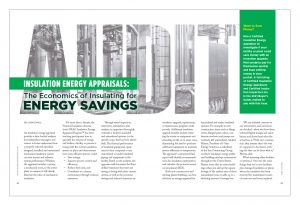Insulation Energy Appraisals: The Economics of Insulating for Energy Savings
An insulation energy appraisal provides a data-backed analysis for facility/plant managers and owners to better understand how a properly selected, specified, designed, installed, and maintained mechanical insulation system can save money and enhance system performance. Whether the appraisal includes a system, a mechanical room, or the entire plant or campus, it will clearly illustrate the value of mechanical insulation.
For more than a decade, the National Insulation Association’s (NIA’s) Insulation Energy Appraisal Program™ has been teaching participants how to quantify the amount of energy and dollars a facility or process is losing with the current insulation system in place and demonstrate how more efficient systems could:
- Save energy,
- Improve process control and efficiency,
- Reduce fuel costs, and
- Contribute to a cleaner environment through reduced emissions.
Through visual inspection, interviews, calculations, and analysis, an appraiser thoroughly evaluates a facility’s insulated and uninsulated systems (or the specific scope that has been identified). The thermal performance of insulated piping and equipment is then compared to any uninsulated or under-insulated piping and equipment in the facility. Based on the analysis, the appraiser will document the Btus/dollars/emissions that users are saving or losing with their current system, as well as the potential savings and reduced emissions an insulation upgrade, replacement, or maintenance program could provide. Additional insulation upgrade benefits include reducing the strain on equipment and extending its life or, in some cases, eliminating the need to purchase additional equipment to maintain system efficiency or temperature. The appraiser’s customized final report will identify recommendations for insulation optimization and calculate the potential return on investment (ROI).
Both new construction and existing plants/buildings can benefit from an energy appraisal for uninsulated and under-insulated systems. For example, in new construction, items such as flange valves, flanged pairs, valves, condensate receivers, and pumps are routinely left uninsulated. Andrew Martin, President of I-Star Energy Solutions, a subsidiary of the Irex Contracting Group, conducts insulation energy audits and building envelope assessments throughout the United States. Martin notes that in newer buildings, when you add up the square footage of the surface area of those uninsulated items, it adds up to a shocking amount of energy loss.
“We use infrared cameras on our assessments, and customers are shocked…when we show them infrared/digital images and calculations and show them what the actual loss is. With new construction, they assume that’s the way it’s supposed to be, there’s nothing else that can be done with it,” Martin adds.
When assessing older facilities or systems, I-Star sees the same things they see in new facilities, plus damaged insulation or places where the insulation has been removed for maintenance issues of some sort and never replaced. Martin notes, “That’s where we find a lot more scope in the older buildings because of maintenance. For example, if a valve leaked, they would remove the wet insulation, but then never replace it.”
What to Expect during the Assessment
The first step in the appraisal process is an interview and discussion with the personnel who know the facility well. This will determine the scope of the appraisal, the scope of a facility’s energy usage and energy distribution systems, and the cost to operate. The appraiser will also review the layout and facility drawings, if available, and determine the major sources of energy serving the facility.
Often the facility walk-through takes place on a follow-up visit. During this step, the appraiser will measure and document all applicable pipes, ducts, and equipment, both insulated and uninsulated (or damaged). The appraiser may also point out areas of concern with uninsulated areas or damaged insulation, such as personnel safety, regulatory compliance, corrosion under insulation, process control, or impact on adjacent equipment.
When I-Star conducts an assessment, they ask for the process temperatures of the systems, the systems’ hours of operation, type of fuel, fuel costs, and system efficiency. “Once we have those five things, we can do our calculations and report back to them,” Andrew says. Regarding how long the on-site assessment takes, it depends on the size of the facility. “If we are in a hospital or larger building with 12 stories and multiple mechanical rooms, it could be multiple days. If there’s only one building, it may only take a few hours. We don’t tie anybody up—we are on our own,” Andrew notes.
Depending on the scope of the appraisal, the certified appraiser will look at:
- Pipe and equipment sizes, locations,and geometries;
- Types of installed insulation and jacketing or protective materials;
- Condition of the current insulation systems;
- Ambient temperature;
- Process temperatures;
- Wind velocity;
- Design relative humidity values;
- Annual hours of operation;
- Scheduled downtimes;
- Current thicknesses of insulation;
- Energy sources;
- Efficiency of each energy unit;
- Type of energy used;
- Cost of energy;
- Process and instrument drawings (if available); and
- Insulation specifications.
Creating a Customized Report
Once the appraiser has completed both the interview with facility staff and the facility walk-through, the next step is analyzing the data using specially-designed, scientific insulation calculators and software. Some of these insulation-specific resources are only available through this program and were developed by NIA and the National Institute of Building Sciences as part of the Mechanical Insulation Design Guide (www.insulation.org/training-tools/systemdesign/), and the 3E Plus® program, which was developed by the North American Insulation Manufacturers Association (NAIMA). Calculations include:
- Heat gain or loss (actual fuel dollar loss),
- Personnel protection and surface temperature requirements,
- Condensation control
- Heat loss efficiencies versus bare pipe,
- Financial calculations, including payback period or ROI, and
- Emission reductions.
Once they have gotten the customer information and completed their on-site assessment, many NIA Certified Appraisers can generate the final report in approximately 10–14 business days.
What Will the Final Report Cover?
The appraiser will present a customized, scientific, data-driven report and explain all financial savings information, as well as energy and environmental data. Reports also may include infrared images that visually capture heat loss.
The final report will provide detailed and well-documented analysis, including:
- Fuel cost savings with the current insulation system, potential upgrades for the system, and potential savings with an insulation upgrade;
- Environmental impact in terms of reduced CO2, NOx, and other greenhouse gases resulting from increased energy savings and reduced fuel consumption;
- Energy (Btu) loss/gain from uninsulated surfaces in the facility;
- Energy (Btu) loss/gain from insulated surfaces in the facility; and
- Btu or energy loss/gain from a pipe or vessel if it is insulated to the most thermally efficient, yet cost-effective, thickness determined by the 3E Plus program.
The appraiser may identify recommendations based on the analysis and discuss the potential ROI from an insulation upgrade or replacement, or from implementation of a timely and effective mechanical insulation maintenance program. If requested, the appraiser also can provide a professional estimate regarding any insulation recommendations.
Putting the Information into Action
When asked what customers typically do upon receiving their report, Martin says he gets several typical responses. “Some say, ‘Wow, that’s a lot more loss than I expected. We’ll try to budget for it in the future.’ Those who are ready to take action may say, ‘This is great. I can take it up the ladder. I have the proof I need to get the funds.’” Martin says people generally know there is a problem, but they do not know the extent of it, and this report shows them the cost of the project, the payback period, and how much they can continue to save in the future.
When systems are properly insulated following an assessment, users will immediately notice a drop in their energy usage and in mechanical rooms, the actual environment changes. Martin added, “everyone sees a drop in temperature in the mechanical room itself just because when you’ve insulated all the steam systems or whatever it may be, the ambient temperature drops 10–15 degrees at times and that’s what the site personnel notice right on the spot.”
He affirms, “there’s energy loss in every building,” and advises “at least allow a certified appraiser someone who’s in the business of mechanical insulation and energy assessments to take a look instead of just saying, ‘We don’t have any energy loss here.’ It will save you money and energy year after year, and can make the environment safer for employees.”
NIA currently has nearly 300 certified Insulation Energy Appraisers throughout the United States. Certified appraisers receive intensive training through NIA’s Insulation Energy Appraisal Program. They can provide an accurate appraisal of your current insulated systems and recommend the steps necessary to achieve the best energy and cost savings and emission reduction possible. To find a NIA Certified Insulation Energy Appraiser in your area, please visit http://tinyurl.com/jr4wzf8.



